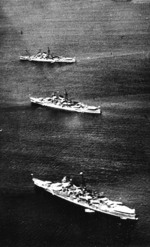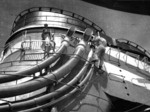![Mikuma file photo [1576] Mikuma file photo [1576]](/images/ship_mikuma1.jpg)
Mikuma
| Country | Japan |
| Ship Class | Mogami-class Heavy Cruiser |
| Builder | Mitsubishi Nagasaki Shipyard |
| Laid Down | 27 Oct 1931 |
| Launched | 31 May 1934 |
| Commissioned | 29 Aug 1935 |
| Sunk | 6 Jun 1942 |
| Displacement | 11,169 tons standard; 13,440 tons full |
| Length | 649 feet |
| Beam | 66 feet |
| Draft | 19 feet |
| Machinery | Geared turbines with four screws |
| Power Output | 152,000 shaft horsepower |
| Speed | 35 knots |
| Crew | 850 |
| Armament | 10x8-in, 9x5-in, 4x40mm anti-aircraft, 12 torpedo tubes |
| Armor | 3.9-in belt, 1.4-in deck, 1-in turrets, 5-in magazines |
| Aircraft | 3 Type 1 reconnaissance aircraft |
Contributor: C. Peter Chen
ww2dbaseMikuma was originally completed in Aug 1935, but was sent back to the shipyards again the next year to repair serious design defects. In 1939, she was equipped with ten 8-in guns and was reclassified a heavy cruiser. Early in the Pacific War she took part in the sinking of the American cruiser Houston and the Australian light cruiser Perth during the Battle of Sunda Straight on 1 Mar 1942. During the Battle of Midway, she was under the command of Rear Admiral Takeo Kurita; after the Japanese carrier fleet was routed, Kurita's task force was recalled to rendezvous with Admiral Isoroku Yamamoto to the west, but the fleet was sighted by American submarine Tambor. During emergency maneuvers to avoid a possible torpedo attack by American submarine Tambor, Mikuma and other ships in her group turned violently. As she avoided being hit by cruiser Kumano, she sailed directly in the path of Mogami, which rammed her. Mikuma's heavy armor lessened the damage, but the port side fuel tank was ruptured, leaving thick oil trail as she sailed; Mogami's bow was crushed, crumpled up for about 40 feet. The two ships slowed to about twelve knots while the other two ships, along with Kurita, continued to steam full speed toward the rendezvous point; although Mikuma was capable of steaming at a high speed, Captain Shakao Sakiyama chose to stay behind to escort the damaged sister ship. On 6 Jun 1942, the trail of leaking oil brought aircraft from American carriers Enterprise and Hornet. After damage by three attack waves and damage from the explosion of her own torpedoes, she sank along with a number of officers and men who chose to go down with the ship. On 9 Jun, American submarine Trout found and rescued two survivors (Chief Radioman Hatsuichi Yoshida and Fireman 3rd Class Kenichi Ishikawa) and took them to Pearl Harbor.
ww2dbaseSources: Midway Dauntless Victory, Shattered Sword, US Navy Naval Historical Center.
Last Major Revision: Sep 2008
Heavy Cruiser Mikuma Interactive Map
Photographs
 |  |  |  |
Mikuma Operational Timeline
| 29 Aug 1935 | Mikuma was commissioned into service. |
| 1 Mar 1942 | HMS Encounter, HMS Exeter, and USS Pope were sunk at the Second Battle of the Java Sea; the ships suffered 7, 54, and 1 killed, respectively. Meanwhile, at the Battle of Sunda Strait, Allied cruisers USS Houston and HMAS Perth intercepted a Japanese invasion force but were both sunk as they attacked; four Japanese transports and a minesweepers were sunk, but two of the transports were later refloated. Also on this date, Japanese troops landed on Java and immediately began marching for Batavia, with the Japanese 2nd Division capturing Serang and the 230th Infantry Regiment capturing Kalidjati airfield at Soebang en route. Finally, Japanese air raids at Surabaya damaged destroyer USS Stewart and Dutch destroyer Witte de With. |
| 1 Apr 1942 | Vice Admiral Jisaburo Ozawa's Malaya Force, Second Expeditionary Fleet, departs Mergui, Burma and steams into the Bay of Bengal in the Indian Ocean Raids to attack merchant shipping. The force includes light carrier Ryujo and cruisers Chokai, Suzuya, Kumano, Mikuma, Mogami, and Yura. |
| 5 Apr 1942 | Following Admiral Jisaburo Ozawa’s force’s attack on the British naval base at Colombo, Ceylon, the force is split creating a Northern Group commanded by Rear Admiral Takeo Kurita consisting of cruisers Kumano and Suzuya; the Center Group consisting of the carrier Ryujo and cruisers Chokai and Yura under Ozawa; and the Southern Group comprised of cruisers Mogami, and Mikuma under Captain Shakao Sakiyama for the purposes of smaller raids against merchant shipping. |
| 6 Apr 1942 | Sakiyama's Southern Group of Mogami, Mikuma and destroyer Amagiri sank four merchantmen totaling 19,000 tons with two of them finished off with torpedoes from Amagiri. |
| 11 Apr 1942 | Jisaburo Ozawa's Force arrived at Singapore to conclude a successful sortie into the Indian Ocean. |
| 5 Jun 1942 | Japanese cruiser Kumano was leading a column of sister Mogami-class cruisers Suzuya, Mikuma, and Mogami withdrawing from Midway. Kumano spotted the surfaced American submarine USS Tambor and ordered an emergency 45-degree turn to starboard, but Mikuma mistakenly made a 90-degree turn. Mogami rammed Mikuma on the portside below the bridge crumpling 40-feet of Mogami’s bow and piercing Mikuma’s fuel tanks, causing her to leak oil uncontrollably. This trailing oil slick led to Mikuma’s demise the following day. |
Please consider supporting us on Patreon. Even $1 per month will go a long way! Thank you. Please help us spread the word: Stay updated with WW2DB: |

» Dutch East Indies Campaign, Java
» Dutch East Indies Campaign, Sumatra
» Fall of the Andaman and Nicobar Islands
» Raids into the Indian Ocean
» Battle of Midway and the Aleutian Islands
Partner Sites Content:
» Mikuma Tabular Record of Movement
- » 1,176 biographies
- » 337 events
- » 44,927 timeline entries
- » 1,245 ships
- » 350 aircraft models
- » 207 vehicle models
- » 376 weapon models
- » 123 historical documents
- » 261 facilities
- » 470 book reviews
- » 28,467 photos
- » 365 maps
Lt. Gen. Lewis B. "Chesty" Puller, at Guadalcanal
Please consider supporting us on Patreon. Even $1 a month will go a long way. Thank you!
Or, please support us by purchasing some WW2DB merchandise at TeeSpring, Thank you!


















